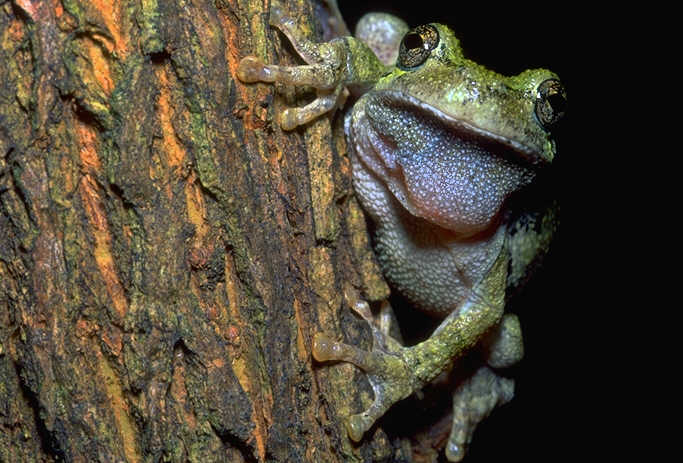Back to Name Page Back
to Sound ID Page Back
to Sight ID Page
Voice: Call is a short raspy trill on one pitch. Call is similar to Hyla versicolor but the pulse rate is faster for a given temperature (34-69 pulses/sec). We have heard them call from late March through October. Calling peaks May through July. This call is quite common in the summer in a wide variety of habitats. They also make a short aggressive barking call which some people confuse with the Barking Treefrog.Habitat: Occurs in a wide variety of habitats. They breed in small ponds and are often found breeding in swimming pools, rain barrels and similar structures. Outside of the breeding season they are arboreal, foraging in the tree canopy. Range: The relative distribution of the two gray treefrogs (Hyla chrysoscelis and Hyla versicolor) is not well known. We have found Hyla chrysoscelis to be common statewide. Identification based on pulse rate analysis that we have conducted has so far shown versicolor to occur only in west Tennessee.
|
 Description: Size 1.2-2 inches (record 2.4 inches). A medium sized treefrog
with expanded toe pads and a pale spot beneath the eye. Its back is
mottled with a varying pattern of grays and greens. Cannot be
distinguished visually from the Gray Treefrog (Hyla versicolor). The
two gray treefrogs can only be separated by the analysis of the pulse rate
of their call, corrected to a standard temperature, or by an analysis of
their chromosomes. Both have apricot orange flash colors. Flash
colors are found on the inside of the thighs and are hidden when the frog is
at rest. The sudden appearance of the flash colors when the frog leaps is
thought to confuse predators.
Description: Size 1.2-2 inches (record 2.4 inches). A medium sized treefrog
with expanded toe pads and a pale spot beneath the eye. Its back is
mottled with a varying pattern of grays and greens. Cannot be
distinguished visually from the Gray Treefrog (Hyla versicolor). The
two gray treefrogs can only be separated by the analysis of the pulse rate
of their call, corrected to a standard temperature, or by an analysis of
their chromosomes. Both have apricot orange flash colors. Flash
colors are found on the inside of the thighs and are hidden when the frog is
at rest. The sudden appearance of the flash colors when the frog leaps is
thought to confuse predators.